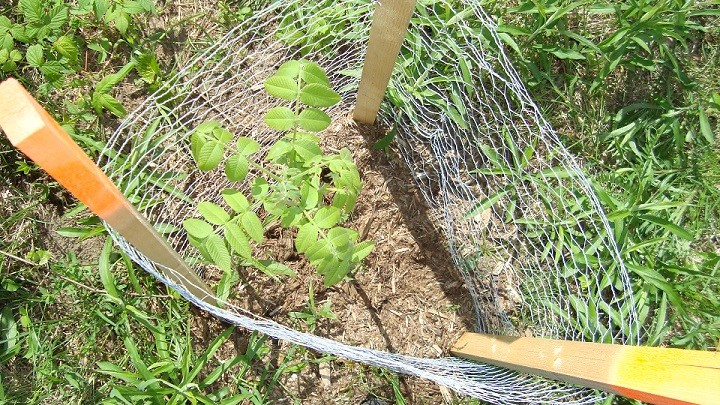Support strong Canadian climate journalism for 2025
Environmental advocates and conservation groups are rallying against proposed amendments to Ontario's Endangered Species Act because protections for vulnerable species will potentially be weakened.
The proposed new rules are easing protections to increase opportunities for various types of development and the creation of mining exploration trails.
In particular, protection parameters are changing for such species as the redside dace, a tiny endangered fish that helps control mosquito populations, and the butternut tree found in southern Ontario, including an area proposed for Highway 413.
Under the proposed amendments, habitat protection for the endangered redside dace minnow would be reduced from 20 to 10 years, potentially allowing development activities in areas inhabited by the fish for less than a decade.
In the case of mining exploration, the changes would nullify current Endangered Species Act (ESA) prohibitions that prevent companies from damaging and destroying habitat for trail-making, said Rachel Plotkin, boreal project manager at the David Suzuki Foundation. However, the new rules would include a suite of mitigation measures to protect caribou, wolverines, grey foxes, polar bears and other birds and small mammals.
Conservationists say the changes prioritize development interests over the protection of at-risk plant and animal species. A letter signed by 68 provincial conservation organizations outlining those concerns was sent last week to Andrea Khanjin, Ontario's minister of environment, conservation and parks.
Canada's National Observer reached out to the Ministry of the Environment, Conservation and Parks (MECP) for details about the proposed amendments but did not receive comments in time for publication. However, on its website, the ministry stated the regulatory changes aim to improve the program, increase “certainty,” and “streamline” processes for Ontarians while continuing to deliver species protection where it is most needed.
Plotkin said the proposed mining trail amendments lay out some mitigation measures but they “just reduce harm. They still allow for it.” And while they are supposed to be mandatory, there is little or no enforcement, she added.
Tim Gray, executive director of Environment Defence, had nothing positive to say about the proposed amendments. “The changes will speed up development approvals and reduce costs for developers engaging in harmful activities that impact Ontario’s most vulnerable plant and animal species,” he said.
Gray pointed out the redside dace and butternut trees, which belong to the walnut family, are just two of many species at risk that would be impacted by the proposed construction of Highway 413 in southern Ontario. “The only reasonable explanation for these proposed changes is to protect highway and sprawl developers from endangered species.”
If the changes are passed, people in the province will be more vulnerable because of weakened natural systems that provide our food, air and water, Gray added.
According to Ontario Nature, nearly 90 per cent of the redside dace population in Ontario can be found in the Greater Toronto and Hamilton area, encompassing the Credit and Humber rivers — both of which would be intersected by Highway 413.
Classified as endangered since 2009, the tiny fish is threatened by habitat loss and water quality decline due to urban and agricultural activities. Redside dace are vital insectivores known to help control mosquito populations.
The ministry is also proposing changes to protections for the butternut tree. Currently, individuals or companies planning work that could harm the tree must submit a health report subject to a 30-day review period by MECP. The proposed amendment would eliminate this waiting period, permitting immediate work activity and potentially endangering the trees, say critics.
In their letter to the minister, conservation organizations noted: “With the proposed amendment, butternut trees could be immediately killed/removed, in which case, questionable or suspect assessments could not be audited.”
Katie Krelove, Ontario campaigner at Wilderness Committee, said the mining exploration trail relaxations will further endanger species.
“It’s tragic to see these proposed exemptions to protections for at-risk species come from the very ministry that is meant to lead the way in ensuring their conservation and recovery,” she said. “The changes have nothing to do with science or ecological knowledge, but instead seem laser-targeted to remove ‘inconveniences’ to developers at the expense of wildlife and the waters, forest and grasslands that support them.”
The group urges the minister to implement the ESA as it was intended, with adherence to the precautionary principle and a firm commitment to protecting and recovering the most vulnerable plants and animals.
“The approach is particularly irresponsible, given the profound challenges we face, if we are to have any hope of addressing the unprecedented and accelerating loss of biodiversity here in Ontario, across Canada and worldwide,” said Anne Bell, director of conservation and education at Ontario Nature. “The proposed changes would serve, first and foremost, the proponents of harmful activities. That is the intent and that would be the outcome. Less habitat would be protected and more species would be exposed to harmful activities.”
As part of the “Get It Done Act,” the Ford government also announced cuts to provincial environmental assessment times for key projects such as highways, railways and electricity transmission lines. This move has been criticized by environmentalists, who argue the change could result in devastating environmental and climate impacts with long-lasting consequences.
“Brick by brick, we’re witnessing the provincial government dismantle the Endangered Species Act, as brick by brick new developments arise in areas that used to be homes for wildlife,” said Plotkin. “This government continues to prioritize industrial resource extraction and development over all other values.”






Comments
In the press release, the Minister of the Environment stated “As Ontario grows at record speed, it’s never been more important to build new roads, highways, public transit and homes, so we can get drivers out of bumper-to-bumper traffic and bring the dream of home ownership into reach for more people”. What she should needs to say is, “As Ontario grows at record speed, it’s never been more important to protect our natural heritage”.
Correct, but you are talking about a Conservative government with the safety net of a majority until 2026 and a horrendous environmental track record which began prior to them even officially taking office as they couldn't wait a hot second to begin on said path. The only solution is to vote them out and use them as a cautionary tale fro how the CPC would behave if elected federally. Donald Trump used to call it "deregulation" and bragged about it almost daily. Sadly, it went right over far too many people's heads which is exactly what Ford and friends are counting on here.
Ive pretty well reached a point where I cant even read watch or listen to the news on most days. Doug and the destroyers told us this was the plan before 2018 election ( eg. ill rip the wind turbines out with my own hands) GOOD OLD TORY VOTERS THOUGHT IT WAS HYPERBOLE
Those of us wary and with mike the knife memory intact, freaked out from day one.
we’ve seen this cynical, drip by water torture drip for years now and their murderous intent is unabated by any good governance rationale , because they were put in power to do EXACTLY what they are doing: obstruct any move off fossil, extract at max speed, and destroy all functioning public institutions ( health, check…. education, check….. environmental oversight, check…..)
most days, i despair. sigh
Yes it is dispiriting and flummoxing to realize just how ignorant uncaring, and blind those who value self interest,, personal aggrandizing and greed can be. Why are we always surprised? The entire evolutionary history of homo un-sapiens is one of successful ego mania and survival bullying.
Now in this supposedly enlightened era, we keep giving power to the worst of our species.
Doug Ford and his corrupt government provide more and more reasons every day why they should be kicked to the curb in the next election. Never vote conservative provincially or federally if you value the environment and acknowledge climate change is real.
The next non-conservative government will need to repair all the damage done by the corrupt Ford government. Doug Ford, only here for his corrupt developer donors.